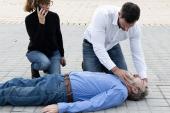Immediate Angiography in OHCA Without STEMI Could Harm: TOMAHAWK and COACT
Researchers delved into the two “neutral” studies using Bayesian methods: a clearer picture of angiography’s role has emerged.

Immediate coronary angiography might, in fact, be harmful for patients with out-of-hospital cardiac arrest (OHCA) but without ST-segment elevation, according to a new Bayesian analysis combining results from the TOMAHAWK and COACT trials.
TOMAHAWK, published in 2021, reassured many harried cardiologists by showing that rushing resuscitated cardiac patients to the cath lab, as opposed to a more selective or delayed approach, didn’t improve 30-day survival (HR 1.28; 95% CI 1.00-1.63). Two years prior, COACT had reached a similar conclusion for 90-day survival (OR 0.89; 95% CI 0.62-1.27).
A decade ago, before the TOMAHAWK and COACT trials kicked off, the prevailing opinion among clinicians was that immediate angiography was probably beneficial, said Steffen Desch, MD (Heart Center Leipzig, Germany), lead investigator of TOMAHAWK and senior author of the new paper. A wait-and-see strategy for angiography has “been adopted quite well” in the years since those trials came out, he told TCTMD.
In part, this is because physicians had long dreaded the need to get up in the middle of the night to do what might be an unnecessary angiogram, he explained. “They were actually quite happy that it turned out the way it did.”
While both trials were “neutral,” there was a signal of harm in TOMAHAWK, Desch pointed out. For the primary endpoint of 30-day mortality, “there’s a P value of 0.06, so that’s borderline,” he explained, adding that this sort of result is especially amenable to exploration with a different statistical strategy.
Based on what the Bayesian analyses showed, “for the majority of patients, a delayed approach is probably the better solution, but there may be an occasional patient where after careful judgment, you still go for immediate angiography,” said Desch. He stressed that “STEMI is still an indication for immediate angiography, as are electrical or hemodynamic instability.”
TOMAHAWK Plus COACT
While the traditional frequentist approach to statistics yields a yes-or-no answer, with the Bayesian approach, “we wanted to have a little more nuance, and that’s probably what it turned out to be,” said Desch. Much like editorials often are published alongside research papers to give added context, Bayesian analyses consider context by incorporating prior knowledge, not just the data generated by the trial itself, he said.
Tharusan Thevathasan, MD (Deutsches Herzzentrum der Charité, Berlin, Germany), lead author of the new paper, agreed the original results had hinted at where the Bayesian results would go.
“So this was rather a confirmation of what we have thought before,” he commented to TCTMD. Although their Bayesian analyses weren’t prespecified, which can be seen as a limitation, they used power calculations done prior to the two trials, said Thevathasan. “Although we knew the study results at the time of our analysis, we tried to be as objective as possible by using the power calculations.”
For their study, published in the December 23, 2024, issue of JACC: Cardiovascular Interventions, Thevathasan and colleagues performed post-hoc analyses in the TOMAHAWK and COACT cohort separately, as well as together. For the Bayesian framework, the researchers explored a spectrum of priors, from flat (every effect equally probable) to neutral (benefit and harm equally probable), optimistic (benefit more likely than harm), and pessimistic (harm more likely than benefit), using assumptions made in the original trial designs.
In TOMAHAWK, immediate coronary angiography showed a posterior probability of 30-day mortality between 90% and 97%, with all of the odds ratios across priors pointing towards harm. In COACT, the potential for harm with angiography ranged from 44% to 72%; here, too, the odds ratios were all “pointing towards harm but slightly more balanced,” the researchers reported.
And when analyzed together, the two trials showed that the likelihood of increased mortality was in the range of 83% to 95%, with odds ratios again all favoring harm.
“These findings may shift the current understanding of both trials from a ‘neutral’ towards a likely ‘harmful’ effect of immediate coronary angiography after successfully resuscitated out-of-hospital cardiac arrest without ST-segment elevations,” Thevathasan et al conclude, adding that the field awaits results from the DISCO trial before delayed angiography can become the preferred practice.
If you go for angio, and you don’t find anything, you really delay the correct diagnosis and the subsequent treatment of course as well. Steffen Desch
Indeed, with results of the current analysis supporting likely harm, there’s the question of whether TOMAHAWK and COACT are, in fact, neutral. “If you’re a Bayesian believer, no,” the data as a whole aren’t neutral, Desch said, though he cautioned, “Of course, this is all exploratory.”
COACT investigator Jorrit Lemkes, MD (Amsterdam University Medical Centre, the Netherlands), who also co-authored the new paper, highlighted one potential driver of mortality with immediate angiography: “An acute coronary syndrome is not always the cause of the arrest in these patients.”
Just 15% of patients in COACT had an acute coronary lesion at the time of angiography, he noted in an email. “Performing immediate coronary angiography might therefore delay the treatment of the real cause of the arrest, resulting in worse outcome. Furthermore, immediate coronary angiography might unnecessarily expose patients to increased procedural risk shortly after cardiac arrest, as most patients in the COACT trial showed stable coronary artery lesions.”
The new analysis, Lemkes told TCTMD, is in line with the 2023 European guidelines for ACS management. He suggested that future research should focus on how to identify patients likely to have an acute coronary occlusion as the cause of their cardiac arrest and those apt to have a favorable neurological prognosis.
Desch also observed that the OHCA population is quite heterogeneous, so teasing out differences among patients will be helpful. Other TOMAHAWK substudies are in the works, including a look at whether ECG data can be used to predict the presence of coronary occlusions that would merit early angiography.
“These are all kinds of patients. These are not only myocardial infarctions: you’ve got your pulmonary embolisms, intracranial bleeding, all kinds of stuff,” he said. “If you go for angio, and you don’t find anything, you really delay the correct diagnosis and the subsequent treatment of course as well.”
In an editorial, Jeffrey J. Rade, MD (University of Massachusetts Chan Medical School, Worcester), predicts that “evidence of potential harm, rather than just a lack of benefit, will undoubtedly better inform clinical decision-making.”
The analysis also makes a strong case for the Bayesian framework as a way to provide more-nuanced information, he adds. “More widespread use of this inductive statistical approach in clinical research has merit, especially as it mirrors the type of reasoning we as clinicians use daily in the diagnosis and treatment of patients.”
Caitlin E. Cox is News Editor of TCTMD and Associate Director, Editorial Content at the Cardiovascular Research Foundation. She produces the…
Read Full BioSources
Thevathasan T, Freund A, Spoormans E, et al. Bayesian reanalyses of the trials TOMAHAWK and COACT. JACC Cardiovasc Interv. 2024;17:2879-2889.
Rade JJ. Timing of angiography after out-of-hospital cardiac arrest without STEMI: sharper images through a different lens. JACC Cardiovasc Interv. 2024;17:2890-2892.
Disclosures
- The study authors and editorialist report no relevant conflicts of interest.





Comments